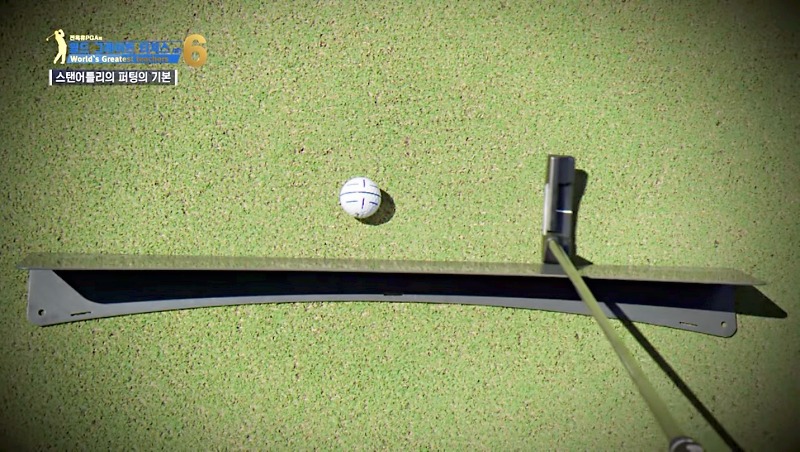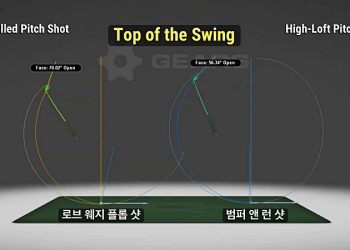PGA나 LPGA 투어 프로들은 어떻게 퍼팅할까? 세계적인 숏게임 교습가인 스탠어틀리는 퍼팅의 요령에 대해 다음과 같이 말한다.
우선 가장 기본은 퍼터를 똑바로 빼서 똑바로 팔로우해야 하는 것이다. 그리고 퍼터 페이스는 볼과 스퀘어 상태를 유지해야 한다. 즉 클럽 패스는 임팩트 순간에 페이스 앵글은 직각 상태를 유지해야 한다고 강조한다.
하지만 실제 퍼터는 라이 각이 수직이 아닌 72도 각도를 내려져 있다. 때문에 퍼팅 스트로크가 진행되면 퍼터 헤드는 스윙면을 따라서 움직인다. 헤드의 움직임이 자연스럽게 아크 형태가 되는 것은 퍼터가 기울어져 있기 때문이다.

많은 골퍼들이 혼란스러워하는 것은 스윙 면을 따라 움직인다는 것과 타겟 라인을 헷갈리기 때문이다. 타겟라인이란 볼이 목표로 움직이기 시작하는 방향이다.
스탠어틀리가 강조하는 퍼팅의 기본은 이런 내용에서부터 출발한다. 그는 자신이 생각하는 아크 형태의 스트로크를 설명하기 위해 보조 도구를 이용한다. 그러면 도구의 기울기 때문에백 스윙 시 퍼터 페이스가 약간 안쪽으로 이동하게 된다.
그 다음 다운스윙이 진행되면서 스퀘어 상태로 임팩트가 되고, 다시 살짝 안쪽으로 진행되면서 팔로우를 하게 된다. 즉 기울어져 샤프트는 같은 각도로 만들어진 보조기구를 따라 진행 시키면, 스트로크를 할 때 약간의 곡선 형태인 아크 스트로크가 된다.
전체적인 타겟 라인과 비교하면 퍼터 페이스가 열리고 닫히는 것처럼 보이지만 사실 페이스는 언제나 헤드의 움직임과 스퀘어 상태를 유지한다.
기본자세부터 다시 살펴보면, 볼의 위치는 중심보다 살짝 왼쪽에 놓인다. 즉 스윙의 최저점을 지난 후에 볼의 임팩트가 발생한다. 머리와 하체를 고정한 후에 양어깨를 이용해서 스트로크를 진행한다.
양어깨의 시소 동작으로 만들어진 백스윙을 진행한 후 멈추어 보면 헤드는 타겟 방향보다는 살짝 안쪽으로 진행하게 된다. 중요한 것은 타겟 라인보다 안쪽으로 진행된 퍼터의 헤드는 클럽 패스의 움직임과 페이스의 각은 직각 상태로 남게 된다.
백스윙을 직선으로 가져간 느낌이지만 실제로는 안쪽으로 진행된다는 것이 스탠어틀리의 생각이다. 즉, 백스윙 상태에서는 페이스 면은 타겟 라인 선상과 비교해서 열린 상태가 된다. 그리고 기울어진 스윙면을 따라 피니시가 진행되면 퍼터의 페이스면은 살짝 닫히게 된다.
중요한 것은 열리고 닫힌 느낌의 스트로크이지만 임팩트 순간에는 언제나 볼과 직각 상태로 만나게 된다는 것이다.
그리고 전체적인 움직임의 진행은 리듬감이 생명이다. 이러한 진행 속도는 인간의 심장 작동수와 비슷하게 이어져야 한다는 것이 대부분의 세계적인 교습가들의 공통된 생각이다.
메트로놈을 이용해서 퍼팅의 스트로크를 진행해 보면 백스윙과 피니시의 안정된 속도감과 리듬감을 갖게 된다. 스윙면을 따라 직각으로 움직이는 아크 형태의 퍼팅 스트로크가 세계적인 숏게임 교습가인 스탠어틀리의 퍼팅 철학이다.
짧은 거리나 긴 거리에서의 템포는 어떻게 진행되는가 하는 질문도 많이 받는데, 정해진 시간 안에서 짧고 긴 거리의 퍼팅 스트로크를 진행하려면 거리가 멀수록 백스윙은 길어지고 임팩트로 되돌아오는 시간은 짧은 거리보다 상대적으로 빠르게 진행된다.
언제나 정교한 속도감과 리듬감을 유지할 수 있다면 퍼팅의 불안감도 사라진다. 많은 생각 속에서 복잡하게 만들어진 퍼팅도 단순해지고 편해진다.
☞ 전욱휴는…
골프 칼럼니스트. PGA 클래스A 멤버이자 공인 티칭 및 코칭 강사다. SBS, MBC, JTBC, YTN 등의 골프 채널에서 진행자 및 해설자로 활약했다. 현재 애틀랜타에서 골프 레슨 및 골프 관련 비즈니스를 하고 있다. chungolf@gmail.com
Dr.Eric Chun’s Golf Lesson 8
What is the basic putting technique common among PGA & LPGA Tour pros?
“Naturally, the backswing and finish should be in an arc shape, and the impact should meet the ball at a right angle.”
The basics of Stan Utley’s putting.
The basics of putting by Stan Utley, a world-renowned short game instructor, are as follows. The most fundamental aspect is that the putter must be pulled straight back and followed through straight. Additionally, the putter’s face must maintain a square relationship with the ball. In other words, it emphasizes that at the moment of impact, the club path should maintain the face angle at a right angle. However, in reality, the putter’s lie angle is not vertical but tilted at a 72-degree angle. Due to this, as the putting stroke progresses, the head of the putter moves along the swing plane, which naturally results in the head’s movement appearing in an arc shape because the putter is tilted. What confuses many golfers is the misunderstanding between moving along the swing plane and the target line.
The target line refers to the direction in which the ball starts moving towards the goal. However, when stroking with a putter that has a 72-degree lie angle, the head naturally moves in an arc shape. Stan Utley’s basic putting philosophy starts from the aforementioned points. He uses training aids to explain the arc-shaped stroke he envisions. Using a training aid to perform the stroke causes the putter’s face to move slightly inwards during the backswing due to the aid’s angle. As the downswing progresses, the face squares at impact and then slightly inwards again during the follow-through. Thus, by following a training aid with the same angle, the stroke forms a slight arc.
Compared to the overall target line, the putter face appears to open and close, but in reality, the face always maintains a square relationship with the head’s angle.
Starting from the basic posture again, the ball’s position is slightly left of center. This means that the ball is impacted after the lowest point of the swing. The stroke is executed using both shoulders, keeping the head and lower body stable. After progressing through the teeter-totter motion of the lead shoulder, if you stop and look, the head of the putter moves slightly inwards from the target direction. It’s crucial that the head of the putter moves inside the target line, maintaining the club path movement and the face angle at a right angle. Although the backswing feels straight, in reality, it progresses inwardly according to Stan Utley’s perspective. This means that during the backswing, the face angle compared to the target line appears open. And as the swing finishes following the tilted swing plane, the putter’s face angle slightly closes. The important part is that even though the stroke feels open and closed, at the moment of impact, it always meets the ball at a right angle. Moreover, the overall progression of movement is vital to rhythm. This progression speed must match the human heart rate as most world-renowned instructors commonly believe.
Using a metronome to carry out the putting stroke provides a stable speed and rhythm for both backswing and finish. The putting stroke that follows a slight arc along the swing plane is Stan Utley’s putting philosophy.
Regarding the tempo for short or long distances, many questions arise, but to maintain the putting stroke tempo for both short and long distances within a set time, the backswing becomes longer for further distances, and the return to impact happens relatively quicker than for shorter distances. If one can always maintain refined speed and rhythm, the anxiety of putting disappears. Many complicated thoughts about putting become simplified and comfortable.




![[전욱휴의 골프레슨] 8. 스탠어틀리의 '퍼팅 기본'](https://www.atlantajoongang.com/wp-content/uploads/2024/05/QQ1KakaoTalk_20240517_064633492_01.jpg)















![[전욱휴의 골프 레슨] 46. 배치기(얼리 익스텐션)](https://www.atlantajoongang.com/wp-content/uploads/2025/03/photoKakaoTalk_20250306_073237889_01-350x250.jpg?v=1741361116)
![[전욱휴의 골프 레슨] 45. 임성재 '행온페이드' 샷](https://www.atlantajoongang.com/wp-content/uploads/2025/02/collage1-350x250.jpg)
![[전욱휴의 골프레슨] 44. 일관된 샷을 원한다면](https://www.atlantajoongang.com/wp-content/uploads/2025/02/QKakaoTalk_20250212_065748485-350x250.jpg)

![[전욱휴 골프 레슨] 42. 오른쪽 팔꿈치 역할](https://www.atlantajoongang.com/wp-content/uploads/2025/01/qQ1KakaoTalk_20250130_072058648-350x250.jpg)
![[전욱휴의 골프 레슨] 41. 매킬로이 파워 스윙](https://www.atlantajoongang.com/wp-content/uploads/2025/01/qQ1KakaoTalk_20250122_123635940-350x250.jpg)
